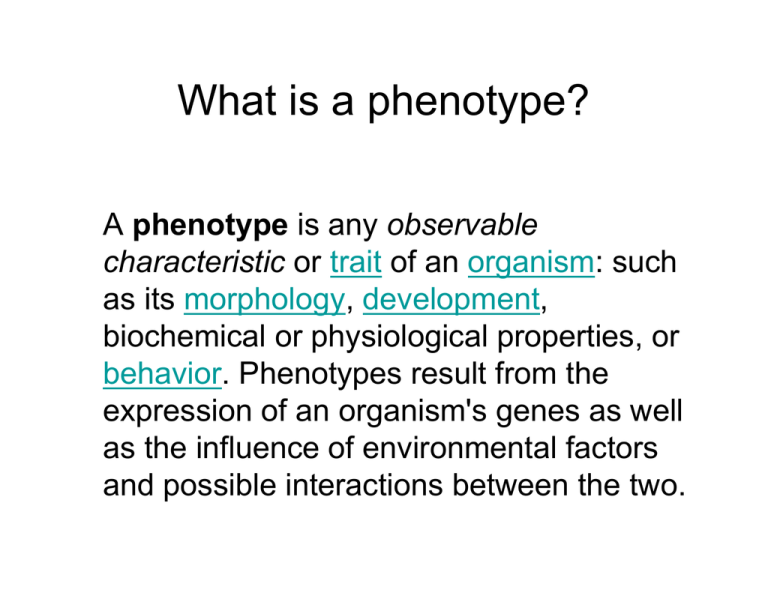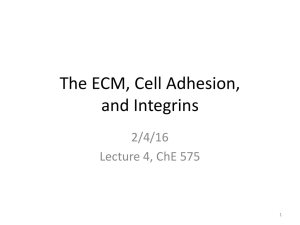Cell Phenotype & Biomaterials: Tissue Interactions
advertisement

What is a phenotype? A phenotype is any observable characteristic or trait of an organism: such as its morphology, development, biochemical or physiological properties, or behavior. Phenotypes result from the expression of an organism's genes as well as the influence of environmental factors and possible interactions between the two. Phenotype changes following cell adhesion on biomaterials • Biomaterials surfaces can function as insoluble regulators of cell phenotype. Interactions between cells and their insoluble environment are increasingly important in tissue engineering and regenerative medicine. • Several cases of cell phenotype regulation by surfaces of ECM analogs (CGS) will be studied in the following section. Figure by MIT OpenCourseWare. After Ricci The migration speed of fibroblasts decreases with average pore size of collagen-GAG scaffolds within the pore size range studied (90-150 μm). Harley, PhD thesis, p. 203, 2006 The migration speed of fibroblasts increases with Young’s modulus of collagen-GAG scaffolds. H l PhD th i 204 2006 The migration speed of prostate cancer cells (DU-145) on a collagen-GAG scaffold is higher than that of normal fibroblasts Harley, PhD thesis, p. 199, 2006 Proliferation rates of various pancreatic cancer cell types on a collagen-GAG scaffold. All curves show data from cancer cells that adhere to the scaffold, except for the data that lie flat on the time axis representing cells that did not adhere. Graph removed due to copyright restrictions. No adhesion Grzesiak and Bouvet, Pancreas 34: 220-228, 2007 Regulation of cancer cells by scaffold surfaces I. Specific interactions of cancer cells with the extracellular matrix have been associated with proliferation and metastasis. There is a steadily increasing interest of cancer investigators to cell-matrix interactions. Cell-matrix adhesion phenomena are widely reported in oncological research. Recently, adhesion to ECM has been defined as enabling and promoting cancer-related processes such as growth, survival, migration, extravasation, homing and metastasis (Schmidmaier and Baumann, 2008). Cell adhesion is cited as protecting from death by radiation and chemotherapy and adhesion molecules are overexpressed on drug resistant cells while clinical trials of anti-adhesion therapies are reported as ongoing (Schmidmaier and Baumann, 2008). Regulation of cancer cells by scaffold surfaces II. Adhesion of proliferating cancer cells to the extracellular matrix (ECM) proceeds by molecular mechanisms that are becoming increasingly clear. A major development is the finding that proliferation of certain classes of tumor cells requires integrin-specific adhesion on ECM substrates. Several integrins have been implicated in processes related to cancer cells. Recently, it has been shown in a large number of studies that the integrins implicated have been the α1β1 and the α2β1, both well-known for many years to be regulators of cell migration and adhesion on collagen-like surfaces. These findings with cancer cells have been supported strongly by demonstration that antibodies directed against one or both of these integrins have inhibited cancer cell proliferation in vitro or tumor growth in vivo. Examples can be cited from studies with several types of tumors, such as osteosarcoma tumor growth in mice (Miura et al., 2005), breast cancer tumor growth in mice (Weaver et al., 1997), and pancreatic cancer cell proliferation in vitro (Srzesiak and Bouvet, 2007). Regulation of cancer cells by scaffold surfaces III. Another, apparently critical, characteristic of migration of cancer cells on ECM-based substrates is the observation that cancer cells employ proteolytic mechanisms, apparently to overcome tissue barriers (Wolf and Friedl, 2006). In one example, depletion of a tumor suppressor protein BRCA2 from metastatic prostate cancer PC-3 cells greatly upregulated matrix degradation and promoted migration and invasion through the matrix; in contrast, overexpression of BRCA2 led to increased proteolysis of matrix due to downregulation of metalloproteinase-9 (Moro et al., 2008). In summary, there are reports in the literature showing clearly that cancer cell proliferation and metastasis depend strongly on integrin-specific adhesion of cells on matrix substrates and on modulation of matrix degradation by the cells. We conclude that understanding of the matrix environment is of critical importance in studies of cancer cell proliferation and metastasis. Starting time of skin wound contraction was inhibited maximally only when scaffold pore diameter was in range 20 — 120 μm. Regeneration observed in this range only.. Scaffolds on skin wounds Defect Contraction Half-life, d 30 20 10 DRT active ungrafted control 0 0.1 1 10 100 1000 1 cm Average Pore Diameter, µm Figure by MIT OpenCourseWare. After Yannas, 1989. MIT OpenCourseWare http://ocw.mit.edu 20.441J / 2.79J / 3.96J / HST.522J Biomaterials-Tissue Interactions Fall 2009 For information about citing these materials or our Terms of Use, visit: http://ocw.mit.edu/terms.





